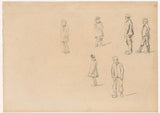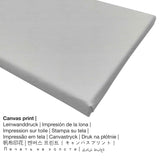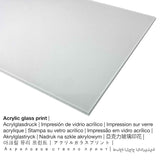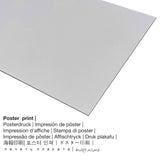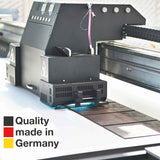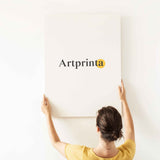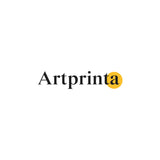Jozef Israëls, 1834 - Ọmụmụ ihe ọgụgụ isii - mbipụta nka mara mma
Ụtụ gụnyere. Mbupu gbakọrọ na ndenye ọpụpụ.
Banyere ihe oyiri nka "Six figure studies"
N'elu 180 afọ artwork e kere site na onye n'akụkọ ihe mere eme artist Jozef Israëls. Besides, this artwork forms part of the Rijksmuseum's nchịkọta ihe osise dijitalụ, nke bụ ihe ngosi nka kacha ukwuu maka nka na akụkọ Dutch site na Middle Ages ruo ugbu a. Nke a nkà nke oge a masterpiece, nke dị na ngalaba ọha a na-agụnye na nkwanye ùgwù nke Rijksmuseum.Ezigbo nka nka bụ: . Na mgbakwunye na nke ahụ, nhazi nke mmepụta dijitalụ dị n'ime odida obodo format na a akụkụ ruru nke 1.4: 1, which implies that the length is 40% longer than the width. Jozef Israëls was a male painter, whose style can primarily be classified as Historicism. The Dutch artist was born in the year 1824 in Groningen,Netherlands and passed away at the age of 87 na 1911 na Scheveningen, Netherlands.
Nhọrọ ihe enwere ike
Anyị na-enye ụdị nha na ihe dị iche iche maka ngwaahịa ọ bụla. Anyị na-ahapụ gị ka ịhọrọ nha na akụrụngwa ọkacha mmasị gị n'etiti nhọrọ nhazi ngwaahịa ndị a:
- Aluminom ihe eji eme ihe: An Aluminium Dibond print is a print with an impressive depth. The non-reflective surface make a fashionable look. For our Aluminium Dibond print, we print the selected artpiece right on the aluminium surface. This direct UV print on aluminium is one of the most popular entry-level products and is an extremely sophisticated way to showcase art, as it draws focus on the whole artwork.
- Glass acrylic ebipụtara nwere mmetụta na-egbuke egbuke (ya na mkpuchi iko n'ezie): The acrylic glass print, which is often referred to as a print on plexiglass, will change your favorite artwork into gorgeous home decoration. The work of art will be printed with the help of modern UV direct print machines. The major benefit of a plexiglass fine art print is that sharp contrasts as well as small image details will be more visible with the help of the delicate tonal gradation in the picture. Our plexiglass with real glass coating protects your selected art print against light and heat for many years to come.
- Mpempe akwụkwọ (ihe kwaaji): The poster print is a printed sheet of flat canvas with a slightly rough texture on the surface, that reminds the actual masterpiece. A poster is qualified for framing the fine art print in a custom frame. Please note, that depending on the absolute size of the canvas poster print we add a white margin of approximately 2-6cm round about the print to facilitate the framing with a custom frame.
- Mbipụta kanvas: The canvas print, which should not be mistaken with a painting on a canvas, is a digital copy printed onto cotton canvas material. How do I hang a canvas on my wall? The great advantage of canvas prints is that they are relatively low in weight, meaning that it is easy to hang your Canvas print without the help of additional wall-mounts. That is why, canvas prints are suited for all types of walls.
Nkwupụta iwu: We try our utmost to describe our art products as accurately as we can and to exhibit them visually in our shop. Although, the tone of the printed materials and the print result may vary to a certain extent from the representation on your screen. Depending on the screen settings and the quality of the surface, not all colors will be printed one hundret percent realistically. In view of the fact that all the are processed and printed manually, there may as well be slight variations in the size and exact position of the motif.
Ozi ederede ahaziri
| Nkewa ngwaahịa: | nka nka |
| Usoro mmeputakwa: | dijitalụ mmeputakwa |
| Usoro nhazi: | Mbipụta UV ozugbo (mbipụta dijitalụ) |
| Mmalite ngwaahịa: | German mere |
| Stockdị ngwaahịa: | mmepụta ihe na-achọ |
| Eji ngwaahịa a chọrọ: | nchịkọta nka (mmeputakwa), ụlọ mmepụta nka nka |
| Nhazi nke ihe nka: | nhazi odida obodo |
| Oke akụkụ: | (ogologo: obosara) 1.4: 1 |
| Mmetụta akụkụ onyonyo: | ogologo bụ 40% ogologo karịa obosara |
| Nhọrọ ihe dị: | ígwè obibi akwụkwọ (aluminium dibond), ebipụta canvas, mbipụta enyo acrylic (nwere ezigbo mkpuchi iko), mbipụta akwụkwọ mmado (akwụkwọ kwaaji) |
| Canvas dị n'elu ihe nrịbama (mbipụta kanvas) nha dị iche iche: | 70x50cm - 28x20", 140x100cm - 55x39" |
| Acrylic glass print (nwere ezigbo mkpuchi iko) nhọrọ: | 70x50cm - 28x20", 140x100cm - 55x39" |
| Nhọrọ nha nke akwụkwọ mmado (akwụkwọ kwaaji): | 70x50cm - 28x20" |
| Ụdị mbipụta Dibond (ihe alumnium) dị iche iche: | 70x50cm - 28x20", 140x100cm - 55x39" |
| Nhazi mbipụta nka: | na-enweghị etiti |
Nkọwa nka ahaziri
| Aha ọrụ nka: | "Six figure studies" |
| Nhazi: | sere |
| Category: | nkà nke oge a |
| Narị afọ nka: | 19th narị afọ |
| Afọ okike: | 1834 |
| Afọ nka: | karịa afọ 180 |
| Ụlọ ihe ngosi nka / ebe: | Rijksmuseum |
| Ebe ebe ngosi nka: | Amsterdam, Netherlands |
| Weebụsaịtị ihe ngosi nka: | Rijksmuseum |
| License: | ngalaba ọha |
| Site n'aka: | Rijksmuseum |
Ozi izugbe gbasara onye na-ese ihe
| Aha onye nka: | Jozef Israel |
| okike onye nka: | nwoke |
| Obodo onye nka: | Dutch |
| Ọrụ nke onye na-ese ihe: | onye na-ese ihe |
| Obodo onye nka: | mba netherland |
| Nhazi nke onye nka: | omenkà nke oge a |
| styles: | Akụkọ ihe mere eme |
| Oge ndu: | 87 afọ |
| Afọ amụrụ: | 1824 |
| Ebe amụrụ onye: | Groningen, Netherlands |
| Afọ nwụrụ: | 1911 |
| Nwụrụ na (ebe): | Scheveningen, Netherlands |
© nwebiisinka site na - Artprinta.com (Artprinta)

